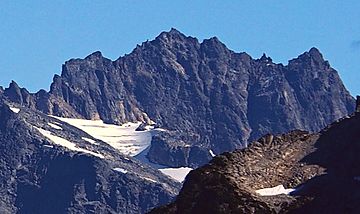Crooked Thumb Peak facts for kids
Quick facts for kids Crooked Thumb Peak |
|
|---|---|

Crooked Thumb Peak, west face
|
|
| Highest point | |
| Elevation | 8,129 ft (2,478 m) |
| Prominence | 444 ft (135 m) |
| Geography | |
| Location | Whatcom County, Washington, U.S. |
| Parent range | North Cascades Cascade Range |
| Topo map | USGS Mount Challenger |
| Type of rock | Gneiss |
| Climbing | |
| First ascent | 1940 Fred Beckey, Helmy Beckey |
Crooked Thumb Peak is a tall mountain in the North Cascades National Park in Washington, USA. It stands about 8,129 feet (2,478 meters) high.
This peak is found in the northern part of the park. It's part of the Picket Range, which is known for its rugged peaks. Crooked Thumb Peak is located about half a mile (0.8 km) south of Mount Challenger. It is also the same distance north of Phantom Peak.
Contents
Weather and Environment
What is a Marine West Coast Climate?
Crooked Thumb Peak is in a special climate zone called the marine west coast climate. This means it gets a lot of rain and snow. This type of weather is common in areas near large oceans.
How Mountains Affect Weather
Most of the weather in this area comes from the Pacific Ocean. Big weather systems, called fronts, move from the ocean towards the Cascade Range. When these fronts hit the tall mountains, the air is forced to rise. As the air goes higher, it cools down. This causes the moisture in the air to turn into rain or snow. This process is called orographic lift.
Rain and Snowfall
Because of this, the western side of the North Cascades gets a lot of precipitation. This is especially true during the winter months. Most of this precipitation falls as snow. The snow here tends to be wet and heavy. This can sometimes lead to a high risk of avalanches, which are large slides of snow down a mountain.
Seasonal Weather Patterns
During the winter, the weather is usually cloudy. However, in the summer, high-pressure systems often form over the Pacific Ocean. These systems bring clear skies and sunshine to the mountains. Any rain or melted snow from Crooked Thumb Peak flows into streams. These streams then join the Skagit River.
How the Mountains Formed
Rugged Landscape of the North Cascades
The North Cascades are famous for their very rugged landscape. You can see sharp, rocky peaks, tall spires, and deep valleys carved by glaciers. The way the land looks today is due to many geological events that happened millions of years ago. These events created the huge changes in elevation and different climates we see now.
Earth's Moving Plates
The history of the Cascade Mountains began millions of years ago. This was during a time called the late Eocene Epoch. The Earth's surface is made of huge pieces called tectonic plates. The North American Plate was slowly moving over the Pacific Plate. This movement caused a lot of volcanic activity.
Building Mountains with Terranes
Also, small pieces of the Earth's crust, called terranes, joined together. These terranes were like puzzle pieces that slowly came together. This process helped create the North Cascades about 50 million years ago.
Shaping by Glaciers
Later, during the Pleistocene period, which was over two million years ago, huge sheets of ice called glaciers covered the land. These glaciers moved forward and backward many times. As they moved, they scraped and carved the landscape. They left behind piles of rock and debris. The "U"-shaped valleys you see in the mountains were carved by these powerful glaciers.
Uplift and Faulting
The mountains also grew taller because of processes called uplift and faulting. Uplift means the land was pushed upwards. Faulting means there were cracks in the Earth's crust where sections of rock moved past each other. These forces, along with the glaciers, created the tall peaks and deep valleys of the North Cascades.



